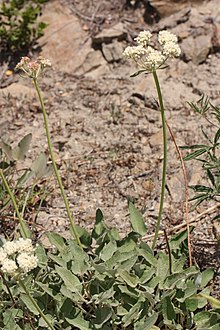User:Karmos/sandbox: Difference between revisions
No edit summary |
No edit summary |
||
| Line 27: | Line 27: | ||
File:Eriogonum compositum var. compositum 4.jpg|''E. compositum'' var. ''compositum'' (flowers) |
File:Eriogonum compositum var. compositum 4.jpg|''E. compositum'' var. ''compositum'' (flowers) |
||
File:Eriogonum compositum 4086.JPG|''E. compositum'' (leaves) |
File:Eriogonum compositum 4086.JPG|''E. compositum'' (leaves) |
||
File:Eriogonum compositum 45117152.jpg|E. compositum (yellow flowered form) |
|||
</gallery> |
</gallery> |
||
Revision as of 05:33, 8 April 2023
| Karmos/sandbox | |
|---|---|

| |
| Eriogonum compositum | |
| Scientific classification | |
| Kingdom: | Plantae |
| Clade: | Tracheophytes |
| Clade: | Angiosperms |
| Clade: | Eudicots |
| Order: | Caryophyllales |
| Family: | Polygonaceae |
| Genus: | Eriogonum |
| Species: | E. compositum
|
| Binomial name | |
| Eriogonum compositum | |
Eriogonum compositum is a species of wild buckwheat known by the common name arrowleaf buckwheat. It is native to the western United States, including California, Oregon, Washington, and Idaho,
--
where it is abundant and found in many habitats, including the sagebrush steppe and alpine areas.[1] It is an extremely variable plant and hard to identify because individuals can look very different from one another. Also, there are many varieties. It may be a perennial herb blooming by summer[1] with stems 10 centimeters tall[citation needed] and two to six clusters of flowers, with a whorl of leaves below the stems,[1] or a sprawling shrub approaching two meters high and wide.[citation needed] The leaves are usually woolly and low on the plant, and the flowers come in many colors from white to bright yellow to purple. Native American groups utilized parts of this plant for a number of medicinal uses.
It is a popular larval host, feeding the bramble hairstreak, desert green hairstreak, lupine blue, Mormon metalmark, Rocky Mountain dotted blue, Sheridan's hairstreak, Sonoran metalmark, and western green hairstreak.[2] Additionally, goats and domestic sheep feed on the plant.[3]
--
Varieties of this species include, but are not limited to:
- E. c. var. compositum - a
- E. c. var. lancifolium - f
- E. c. var. leianthum - a
- https://burkeherbarium.org/imagecollection/taxon.php?Taxon=Eriogonum%20compositum
-
E. compositum var. compositum (flowers)
-
E. compositum (leaves)
-
E. compositum (yellow flowered form)
References
- ^ a b c Taylor, Ronald J. (1994) [1992]. Sagebrush Country: A Wildflower Sanctuary (rev. ed.). Missoula, MT: Mountain Press Pub. Co. p. 30. ISBN 0-87842-280-3. OCLC 25708726.
- ^ The Xerces Society (2016), Gardening for Butterflies: How You Can Attract and Protect Beautiful, Beneficial Insects, Timber Press.
- ^ Reiner, Ralph E. (1969). Introducing the Flowering Beauty of Glacier National Park and the Majestic High Rockies. Glacier Park, Inc. p. 32.
External links
 Media related to Eriogonum compositum at Wikimedia Commons
Media related to Eriogonum compositum at Wikimedia Commons- Jepson Manual Treatment
- Ethnobotany
- Photo gallery
- Eriogonum
- Flora of the Northwestern United States
- Flora of California
- Flora of the Cascade Range
- Flora of the Rocky Mountains
- Flora of the Sierra Nevada (United States)
- Flora of the California desert regions
- Natural history of the California chaparral and woodlands
- Natural history of the California Coast Ranges
- Natural history of the Peninsular Ranges
- Natural history of the Transverse Ranges
- Flora of Oregon
- Flora of Washington (state)
- Flora of Idaho



